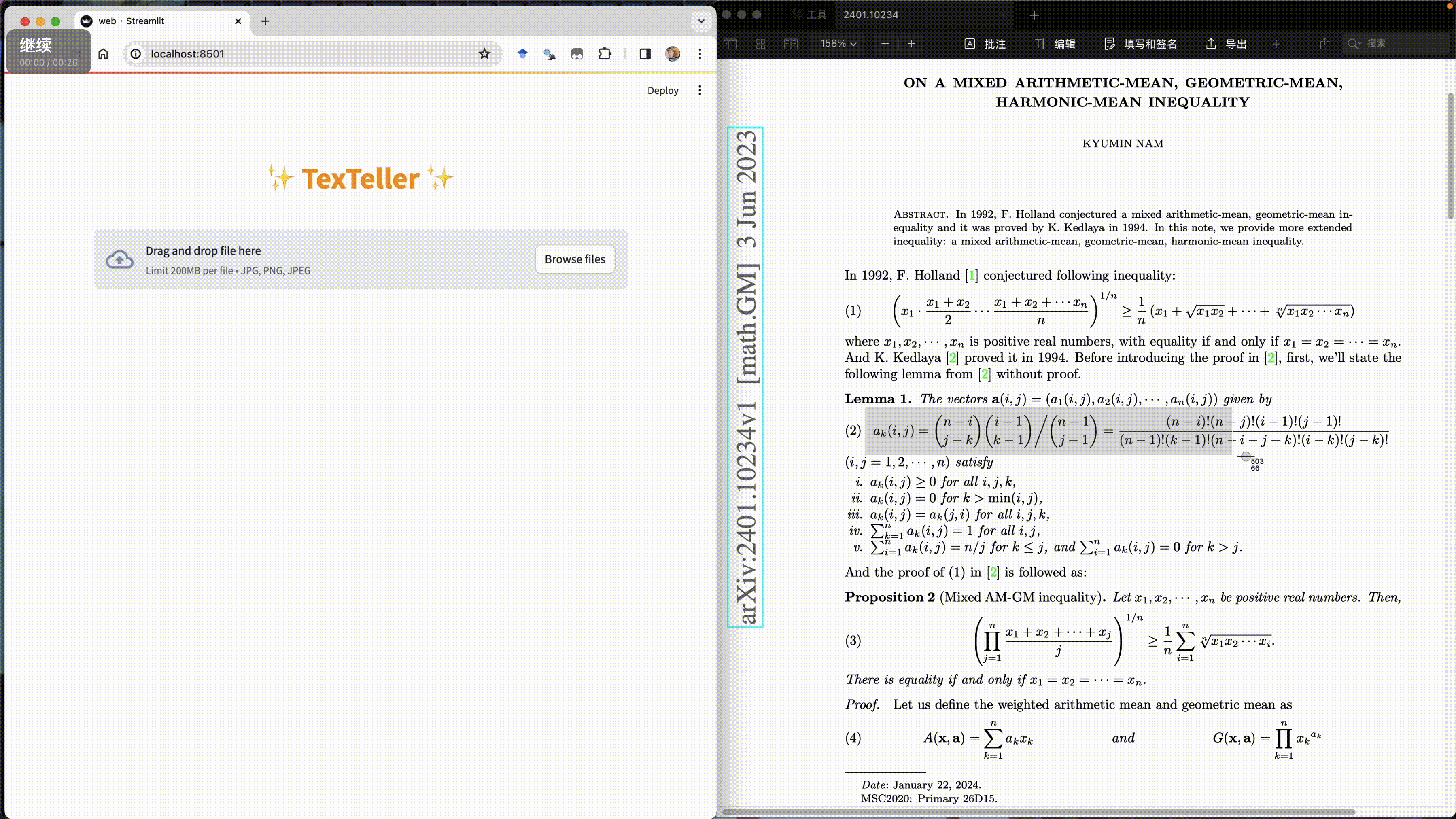TexTeller is a ViT-based model designed for end-to-end formula recognition. It can recognize formulas in natural images and convert them into LaTeX-style formulas.
TexTeller is trained on a larger dataset of image-formula pairs (a 550K dataset available here), exhibits superior generalization ability and higher accuracy compared to LaTeX-OCR, which uses approximately 100K data points. This larger dataset enables TexTeller to cover most usage scenarios more effectively( excluding scanned images and handwritten formulas ).
A TexTeller checkpoint trained on a 5.5M dataset will be released soon.
python=3.10
pytorch
Note: Only CUDA version >= 12.0 have been fully tested, so we recommend using CUDA version>=12.0
-
Clone the repository:
git clone https://github.com/OleehyO/TexTeller
-
After pytorch installation, install the required packages:
pip install -r requirements.txt
-
Navigate to the
TexTeller/srcdirectory and run the following command to perform inference:python inference.py -img "/path/to/image.{jpg,png}" # use -cuda option to enable GPU inference #+e.g. python inference.py -img "./img.jpg" -cuda
Checkpoints will be downloaded in your first run.
You can also run the web demo by navigating to the TexTeller/src directory and running the following command:
./start_web.shThen go to http://localhost:8501 in your browser to run TexTeller in the web.
You can change the default settings in
start_web.sh, such as inference with GPU(e.g.USE_CUDA=True) or increase the number of beams(e.g.NUM_BEAM=3) for higher accuracy.
We use ray serve to provide a simple API for using TexTeller in your own projects. To start the server, navigate to the TexTeller/src directory and run the following command:
python server.py # default settingsYou can pass the following arguments to the server.py script to get custom inference settings(e.g. python server.py --use_gpu to enable GPU inference):
| Argument | Description |
|---|---|
-ckpt |
Path to the checkpoint file to load, default is TexTeller pretrained model. |
-tknz |
Path to the tokenizer, default is TexTeller tokenizer. |
-port |
Port number to run the server on, default is 8000. |
--use_gpu |
Whether to use GPU for inference. |
--num_beams |
Number of beams to use for beam search decoding, default is 1. |
--num_replicas |
Number of replicas to run the server on, default is 1. You can use this to get higher throughput. |
--ncpu_per_replica |
Number of CPU cores to use per replica, default is 1. |
--ngpu_per_replica |
Number of GPUs to use per replica, default is 1. You can set this to 0~1 to run multiple replicas on a single GPU(if --num_replicas 2, --ngpu_per_replica 0.7, then 2 gpus are required) |
Client demo can be found in
TexTeller/client/demo.py, you can refer todemo.pyto send requests to the server.
We provide a dataset example in TexTeller/src/models/ocr_model/train/dataset, and you can place your own images in the images directory and annotate the corresponding formula for each image in formulas.jsonl.
After the dataset is ready, you should change the DIR_URL variable in .../dataset/loader.py to the path of your dataset.
If you are using a different dataset, you may need to retrain the tokenizer to match your specific vocabulary. After setting up the dataset, you can do this by:
-
Change the line
new_tokenizer.save_pretrained('./your_dir_name')inTexTeller/src/models/tokenizer/train.pyto your desired output directory name.To use a different vocabulary size, you should modify the
VOCAB_SIZEparameter in theTexTeller/src/models/globals.py. -
Running the following command under
TexTeller/srcdirectory:python -m models.tokenizer.train
To train the model, you can run the following command under TexTeller/src directory:
python -m models.ocr_model.train.trainYou can set your own tokenizer and checkpoint path(or fine-tune the default model checkpoint if you don't use your own tokenizer while keeping the same model architecture) in TexTeller/src/models/ocr_model/train/train.py.
Please refer to
train.pyfor more details.
Model architecture and training hyperparameters can be adjusted in TexTeller/src/globals.py and TexTeller/src/models/ocr_model/train/train_args.py.
We use the Hugging Face Transformers library for model training, so you can find more details about the training hyperparameters in their documentation.
-
Train our model with a larger amount of data(5.5M samples, and soon to be released).
-
Inference acceleration.
-
...
Thanks to LaTeX-OCR which has brought me a lot of inspiration, and im2latex-100K which enriches our dataset.
